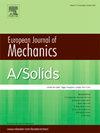考虑法向和剪切能梯度的缺口构件多轴疲劳寿命预测
IF 4.2
2区 工程技术
Q1 MECHANICS
引用次数: 0
摘要
临界距离理论(TCD)是一种简单可靠的评价准则。考虑到基于能量参数的模型可以同时考虑应力和应变响应,构建了基于能量的TCD模型。同时,利用修正能量梯度对缺口几何特征效应进行表征,将缺口效应与几何尺寸效应相结合。采用法向/剪切能梯度修正法向/剪切临界距离,提出了一种计算等效应变能密度的新方法。定义了临界平面梯度比来描述剪切能和法向能对疲劳损伤的影响。基于上述分析,本文提出了一种基于能量的TCD和缺口元件预测方法。对Q355(D)进行疲劳试验,选取现有材料(En8钢、En3B钢、C40钢、TC4合金、7050-T7451合金)的试验数据对提出的模型进行验证。将能量- tcd方法(点法和线法)的计算结果与其他典型的基于能量的模型(SWT模型、MSWT模型、Liu模型、CXH模型)进行了比较,表明所提模型具有更好的精度。本文章由计算机程序翻译,如有差异,请以英文原文为准。
Multiaxial fatigue life prediction of notched components considering normal and shear energy gradient
Theory of critical distance (TCD) is a simple and reliable evaluation criterion. In view of the fact that the model based on energy parameters can take both stress and strain responses into account, the energy-based TCD is constructed. Meanwhile, the modified energy gradient is used to characterize the notch geometric feature effect, which integrates the notch effect and the geometric size effect. The normal/shear energy gradient is employed to correct normal/shear critical distance, and a novel approach for calculating equivalent strain energy density is presented. The critical plane gradient ratio is defined to depict the effect of shear energy and normal energy on fatigue damage. As to the analysis above, an energy-based TCD and prediction procedure of notched components are developed. The fatigue test of Q355(D) is carried out, and the existing test data of materials (En8 steel, En3B steel, C40 steel, TC4 alloy, 7050-T7451 alloy) are selected to verify the proposed model. The calculation results of the energy-TCD approach (point method and line method) are compared with other typical energy-based models (SWT model, MSWT model, Liu model, CXH model), and the proposed model obtained better precision.
求助全文
通过发布文献求助,成功后即可免费获取论文全文。
去求助
来源期刊
CiteScore
7.00
自引率
7.30%
发文量
275
审稿时长
48 days
期刊介绍:
The European Journal of Mechanics endash; A/Solids continues to publish articles in English in all areas of Solid Mechanics from the physical and mathematical basis to materials engineering, technological applications and methods of modern computational mechanics, both pure and applied research.

 求助内容:
求助内容: 应助结果提醒方式:
应助结果提醒方式:


